
Rare Book Scholarship by Dr. Catherine Brown Tkacz
The following scholarship was created by Dr. Catherine Brown Tkacz. In 2006, Fr. Robert J. Spitzer, S.J., President of Gonzaga University, hired Dr. Tkacz as a consultant to advise toward the provision of scholarly access and to improve cataloging of the rare book colleciton.
Nearly 1800 titles in over 3,000 volumes comprise the The Gonzaga Collection: Rare Books from what was the Jesuit Oregon Province. This page provides cursory information on the collection.
Much of the collection had been the property of Mount St. Michael’s, a scholasticate for Jesuits, established in Spokane in 1916. The Mount was considered one of the finest Jesuit houses of study in the world, partly because of its magnificent 50,000+ volume library including the rare books collection. An observation made by French philosopher Etienne Gilson, who visited the Mount’s library in the early 1950s, testifies to the collection’s importance: "I cannot think of a better place to study philosophy in the whole of North America because of what the Mount has in its collection." Mount St. Michael’s closed in 1970, at which time the scholastics and the library collection – including the rare books – were moved to the Gonzaga University campus. The other books in this collection are from other Jesuit institutions within the Oregon Province, principally the juniorates at Sheridan, Oregon, and at Port Townsend, Washington, as well as missions in the Alaska Territory and in Montana.
Notable are incunabula, books printed in the earliest years of printing, before 1500. The Roman Missal of 1484 records the pre-Tridentine Latin liturgy, and Gonzaga owns one of only two known copies outside the Vatican. Fifteenth-century printers often recycled old manuscripts by using them in lieu of end-papers: The 1490 Summa Theologica by Antoninus is all the more valuable, for instance, because it has manuscript leaves from 1290 as its "paste downs."
A wealth of valuable sixteenth-century volumes is also in the collection, including the 1518 edition of Thomas Aquinas’ commentary on Aristotle’s De anima; it appears to be the only copy in the world. Not only does Gonzaga own the full set of Luther’s Opera Omnia (1556-1558): Philip Melancthon and Paul Eber, Luther’s colleagues, personally handwrote in it their own commentaries on specific verses.
The Dominican Missal of 1521, in elegantly marbled slipcase and with abundant woodcuts, sheds valuable light on the Christian tradition of respect for women: The woodcut used for All Saints and also for the liturgy for One or More Apostles shows several saints, male and female, on a hillside, and above them in the sky is a scroll with the words "Hii sunt mei filii delecti," the words that God spoke of Jesus at the Transfiguration, here made plural, indicating that the saints have become Christlike. Manifestly women are included equally with men.
The earliest volumes of the landmark Douai-Rheims edition of the Bible in English are owned by Gonzaga, as are valuable facsimile editions of major ancient manuscripts of the Bible at Mount Sinai, the Vatican, St. Petersburg, and elsewhere.
Two unique seventeenth-century manuscripts with commentaries on Aristotle’s Physics written by Jesuits are within the collection.
Education and the intellectual foundation of the faith are of basic importance in the Jesuit tradition, and this has held true in the Pacific Northwest, as is vividly attested through the book stamps in these rare books. Even the Jesuit missionaries to the territory of Alaska took with them works on theology published in 1621 and 1710. Even the Juniorate library in Sheridan, Oregon, had a scholarly facsimile edition of the celebrated Book of Armagh (begun 807-08), with the earliest documents pertaining to St. Patrick.
75% of The Gonzaga Collection is in Foley Library's online catalog. For the other titles, a five-volume Finding Aid is available in the Rare Book Reading Room. If you are outside the Spokane area and would like further information on a volume identified through the online inventory, please contact Special Collections at uasc@gonzaga.edu or 509-313-3873.
A resource for research into intellectual history and institutional history of the Inland Northwest and a rich resource for such study of the Jesuits in particular consists in the book stamps, plates, stickers, and owner notes found in the volumes of The Gonzaga Collection: Rare Books from the Jesuit Oregon Province. This preliminary finding aid treats only a small portion of such evidence. A few years ago Ms. Sharon Prendergast, then Library Assistant in Special Collections, prepared a list of eighteen volumes with various book stamps, for Fr. Fredric W. Schlatter, S.J. The present list greatly expands on her list.
Alphabetical order governs this list. If the owner was an institution, the entry is alphabetized here by the first word of the stamp, plate, sticker, or note. If the owner was a private person or bookseller, then the entry is alphabetized by the surname (in all capital letters) of that person. Entries are given with the capitalization and punctuation found in the original. Details of shape of the stamp, etc., and color of ink are sometimes noted to help the cataloger or researcher identify additional occurrences of the same stamp. Where it is known, the proper form of the name of the institution is also indicated so that it can be included as an Added Entry in the electronic catalog record. In the quoted text of the book stamps and stickers and plates, sometimes a slash mark (/) is used to indicate line breaks to aid the researcher in identifying exact matches of the same stamp, sticker or plate. These slashes will most likely not be included in electronic catalog records. Finally, included in the alphabetical list are proper names of cities and states, etc., with "see" references to the pertinent book stamps. That is, one can look up "Oregon" and be directed to stamps of the Oregon Province.
Other book stamps not listed below are in A62; L45; Spec Coll. BS64.V2 1868 OVERSIZE. A handwritten owner note is in vol. 1 of F31. At least one volume bears a book stamp for Spokane Falls in Washington Territory, but any note of which volume that is has been lost. Also, at least one volume holds a book stamp showing the ownership of John Evelyn (1620-1706), the famous diarist and friend of Samuel Pepys.
(Catherine Brown Tkacz, September 27, 2006)
ALASKA MISSION, S.J., HOLY CROSS RESIDENCE: purple book stamp. On title page of L67; in L84. Include added entry: St. Michael’s Jesuit Mission (Saint Michael, Alaska)
ANSON: Thomas Anson Esq, engraved with crest: Book plate. Inside front cover of A1 1693
BAKER: Sold by Thomas Baker...:[book dealer]: Book sticker. In B78, D34, etc. Marshall card for B63: "On inside covers: Pasted in label of Thomas Baker, London, the bookseller." Also found in volumes in the stacks in Foley, e g.: BV170.H5, v. 1.
BIB. COLL. VALGIR. S.J.:
Book plate. In L44; L65. Compare this to GYMNAS. IMM. CONC. SOC. IES. / PARIS. AD VALL. GIR. / IHS
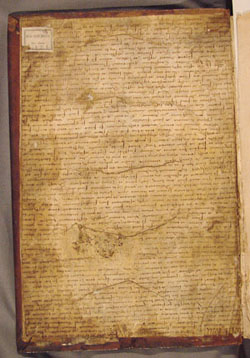
Bibl. Coll. Bolon. / Soc. Jesu.: Book plate.
Inside front cover of A42. Probably from Bologna.
BIBLIOTHECA / SEATTLE, WASH., oval book stamp with, in center: C. SS. R. ad SS. Con. Jesu. On t.p. of M16. Added name: Congregatio Sanctissimi Redemptoris (C. SS. R.)
Bibl[iotheca] Junioratus Prov. Oreg. S.J.: oval book stamp. On verso of front fly leaf of D34
BIBL[IOTHECA] SCHOLASTICATUS / PROV. CALIF. Circular book stamp (1 15/16" diam.) in purple ink, with the words placed in the upper and lower arcs. Inside this stamp, above the word CALIF. is a second, small stamp, curved to nest above the word "CALIF." This second stamp reads simply: OREG. S.J. The pair are found in A9; G 65; L55, vol. 1; on front fly leaf and t.p. of L43; on front fly leaf of L60; on front inner fly leaf and t.p. of L76; inside front cover of M78; on front fly leaf of O6; on front fly leaf of S71; front fly leaf of T80. Also: BX890.D74 1891: Joannis Duns Scoti opera omnia (Parisiis: apud L. Vivès, 1891-1895), 26 vols. [seen 7-17-06]. The Marshall card for C37 notes the presence of the California stamp – has that book also got the stamp for OREG. S.J.? Added entries: "Jesuits. California Province" and "Jesuits. Oregon Province, 1932-."
BIBL[IOTHECA] SCHOLASTICATUS / PROV. CALIF. / CURSUS PHIL. Circular book stamp (1 15/16" diam.) in purple ink, with the words placed in the upper and lower arcs and across the center. Inside this stamp, above the word CALIF. is a second, small stamp, curved to nest above the word "CALIF." This second stamp reads simply: OREG. S.J. The pair are found in on the second fly leaf of V32. Added entries: "Jesuits. California Province" and "Jesuits. Oregon Province, 1932-."
BIBL[IOTHECA] SCHOLASTICATUS / PROV. CALIF. / CURSUS THEOL. Circular stamp (1 15/16" diam.) in purple ink, with the words placed in the upper and lower arcs and across the center. Inside this stamp, above the word CALIF. is a second, small stamp, curved to nest above the word "CALIF." This second stamp reads simply: OREG. S.J. The pair are found in L 17; front fly leaf of M42; inner fly leaf of M53; front fly leaf of S36; front fly leaf of S76. Added entries: "Jesuits. California Province" and "Jesuits. Oregon Province, 1932-."
BIBL[IOTHECA] SCHOLASTICATUS / PROV. OREG. S.J. Circular book stamp found in volumes in the Stacks of Foley: BV170.H5 v. 1 (=Henry Bradshaw Society). Added entry: "Jesuits. Oregon Province, 1932-."
BIBL. SEC. COLL. ROM. SOC. IESV.: In O6
BIBL[IOTHECA] THEOLOGATUS / PROV. CALIFORNIAE / S.J.: oval book stamp with S.J. in center. In A 5, vol. 1. Added entry: "Jesuits. California Province."
Bologna: see Bibl. Coll. Bolon.
California: see stamps beginning BIBL[IOTHECA] SCHOLASTICATUS and BIBL[IOTHECA] THEOLOGATUS.
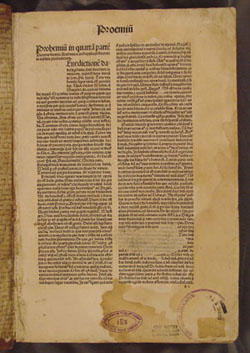 COLLEGIUM TUQUETANUM / BEATÆ MARIÆ VIRGINIS: oval book stamp in purple ink with IHS in the center. Note the central IHS (the abbreviation for the holy name of IHesuS) with the cross above and the three nails of the crucifixion below: two nails for Jesus' hands and one for his overlapped feet. In A 42. From a Jesuit college in Tuquet, near Mouscron in Belgium.
COLLEGIUM TUQUETANUM / BEATÆ MARIÆ VIRGINIS: oval book stamp in purple ink with IHS in the center. Note the central IHS (the abbreviation for the holy name of IHesuS) with the cross above and the three nails of the crucifixion below: two nails for Jesus' hands and one for his overlapped feet. In A 42. From a Jesuit college in Tuquet, near Mouscron in Belgium.
 COLL. MAX. S.J. LOVAN. / BIBLIOTHECA, round red stamp with IHS in center. From Louvain. In A9, with the number 140787 added on verso of tp.; A42
COLL. MAX. S.J. LOVAN. / BIBLIOTHECA, round red stamp with IHS in center. From Louvain. In A9, with the number 140787 added on verso of tp.; A42
DODSON: Chas. Gaskell Dodson: book plate. Inside front cover of each volume of zz004 = Spec Coll. PS1862.A1 1860.
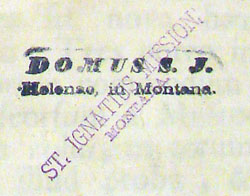
DOMUS S.J. / HELENAE, IN MONTANA.
book stamp. On front fly leaf of M42, where it has been overstruck by a purple book stamp of the St. Ignatius Mission.
Duplum Bibl[iothecae] Reg[iae] Monacensis. The Marshall card reports this for B95. I expanded the abbreviation from records in WorldCat. "Monacensis" is the toponymic for Munich.
Duplum V.E.: book stamp. On half-title page of O6
ÉCOLE SAINTE GENEVIÈVE B.D.J.: oval book stamp in rust-colored ink. On t.p. of L76
EVEYLN, John: book stamp [in a volume not identified]. Added entry: Evelyn, John, 1620-1706
Ex Bibliotheca / majori Coll. Rom. / Societ. Jesu: rectangular book sticker. Inside front cover of O6
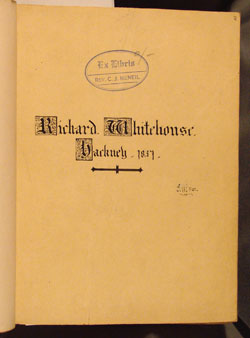
Ex Libris / Rev. C. J. McNeil: In B62.
Rev. McNeil was a diocesan priest from Canada whose brother was a Jesuit priest of the Oregon Province (Information from Fr. Schlatter).
France: See Paris and ÉCOLE SAINTE GENEVIÈVE
Frederick, Maryland: see NOVITIATE FREDERICK
Garant & Trudel Libraire, Quebec: oval book stamp in teal ink. In M16.
GONZAGA COLLEGE / Science Department / Spokane, Wash.: book stamp. Inside front fly leaf of V32
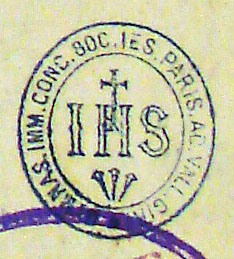
GYMNAS. IMM. CONC. SOC. IES. / PARIS. AD VALL. GIR. / IHS:
oval book stamp in teal ink with IHS in center: L55, vol. 1, tp.; also BX3704.A2 1827, copy 2 (formerly J18 v. 1)
Compare this to BIB. COLL. VALGIR. S.J. (above).
ISTED: Ambrose Isted Esq: Book plate. On verso of tp of E9.
Italy: see Bologna and Rome.
JESUIT FATHERS LIBRARY ST. IGNATIUS MISSION, St. Ignatius Montana: oval book stamp. On t.p. and on p. ã ij of zz020; on front fly leaf of S71
Jesuit Scholasticate Library / Spokane, Washington. Bookplate. In D34, v. 1. Inside front cover of W11. In SPEC COLL BS64.V2 1868. Dr. Michael W. Tkacz also showed me a plate reading "Jesuit Scholasticate Library, Spokane, Washington" with a stamp "Philosophy Seminar Room" in a volume of the valuable Borgnet edition of St. Albertus Magnus (BX890.A4 1890).
Jesuit / Scholasticate / Library / SPOKANE, WASHINGTON, sticker. Beneath it, the stamp: PHILOSOPHY SEMINAR / ROOM. Inside front cover of Albertus Magnus, Opera Omnia, v. 12 ( Oversize BX890.A4 1951, v. 12). Also in vol. 1 and v. 72 of BV170.B5 in the STACKS (Henry Bradshaw Society)
Juniorate Library / St. Francis Xavier Novitiate / Sheridan, Oregon: book stamp. On front paste down and facing fly of SPEC COLL OVERSIZE Z114.C677 (Lowe, Codices latini antiquiores), also on verso of front fly leaf of D34, also on flyleaf [1] of each volume of V25 Virgil’s Aeneis (now PA6807 .A5B7 1716). Added entry: St. Francis Xavier Novitiate, Sheridan, Oregon, 1932-1966 (it then became a scholasticate, 1966-1983). Formally named "Jesuit Novitiate of Sheridan, Oregon," on April 14, 1936 (information from Fr. Fredric W. Schlatter, S.J., in August 2006).
KNIGHT: "Gift of ... / Date..." stamp, filled in: Mr. R. E. Lee Knight, May 3, 1954. Inside front cover of G30
Library of Congress: Book plate. Inside front cover of A1 1693.
|
Livraria d_ Carm. De __ ____: handwritten owner note. [Note: Livraria is the Spanish and Portuguese word for Library.] On t.p. of vol. 1 and vol. 2 of L55. |
Louvain: see COLL. MAX. S.J. LOVAN
 "Manresa Hall Library, Pt. Townsend, Wash." – Book stamp in zz065, now Special Collections BX2349.D74 1630 (Jeremias Drexel, S.J., Gymnasium patientiae).
"Manresa Hall Library, Pt. Townsend, Wash." – Book stamp in zz065, now Special Collections BX2349.D74 1630 (Jeremias Drexel, S.J., Gymnasium patientiae).
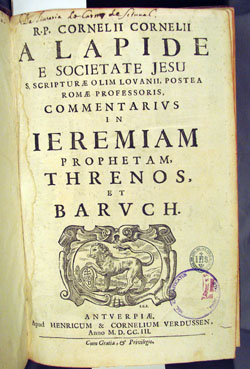
Maryland: see NOVITIATE FREDERICK
McCLURE: Edmund McClure, A.M. (Engraved with image and motto): Book plate. In B78.
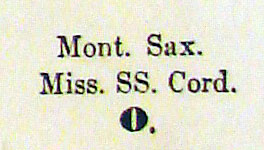
Mont. Sax. / Miss. SS. Cord.:
rectangular book sticker of Rocky Mountains Mission. On t.p. of L43; on t.p. of L60.
Montana: see stamps beginning DOMUS S.J. HELENAE and JESUIT FATHERS and ST. IGNATIUS.
[Mount St. Michael’s–check details], embossed book stamp. On t.p. of A54. Added entry: Mount St. Michael’s, Spokane, Washington, 1916-1970. Formally named Mount St. Michael’s Seminary of Philosophy and Science; Spokane, Washington, on August 27, 1957 (information from Fr. Fredric W. Schlatter, S.J., in August 2006).
Munich: see Duplum Bibl[iothecae] Reg[iae] Monacensis.
NOVITIATE FREDERICK, book stamp: From Frederick, MD, one of the earliest Jesuit novitiates in the U.S. On t.p. of S76
OLD BOOKS / MT. ST. MICHAELS / SPOKANE, WASH.: rectangular book stamp. In B78, inside front cover of G30; G 65; inside front cover of T72; inside front fly leaf of V32; inside front cover of zz020. Added entry: Mount St. Michael’s, Spokane, Washington, 1916-1970.
Oregon: In addition to stamps beginning with this word, see "Juniorate Library" and "St. Francis Xavier Novitiate."
OREG[ON]. S.J.: A small, curved stamp, designed to be stamped just above the word "CALIF." in the circular book stamp of the California Province. Once the Oregon Province was established in 1932, it acquired ownership of several books that had been owned previously by the California Province, of which Oregon had been a part. For books with the Oregon stamp, see stamps beginning BIBL[IOTHECA] SCHOLASTICATUS. In at least one volume, ownership by the California Province had been indicated by a penned note on the flyleaf, not a book stamp, and the curved OREG. S.J. stamp appears there solo. Added entry: Jesuits. Oregon Province, 1932-.
Oregon Jesuit Mission 1829: penned owner note inside front cover of T80.
[Oregon Province]: L17
Paris: See BIB. COLL. VALGIR... and GYMNAS. IMM. CONC....
PLUMPTRE: Russell Plumptre, M.D. (d. 1793), Regius Professor of Physic at Queen’s College Cambridge from 1741 onwards. Penned owner inscription on on flyleaf [2] of each volume of V25 Virgil’s Aeneis (now PA6807 .A5B7 1716): "E Libris/ Russelli Plump[tre]/ Coll: Regin: Cantab:". Added entry: Russell Plumptre, M.D. (d. 1793), Regius Professor of Physic [!] at Queen's College Cambridge.
Port Townsend: see "Manresa Hall Library, Pt. Townsend, Wash."
Rocky Mountains Mission: see below, also stamp beginning Mont. Sax.
ROCKY MTS. MISSION: book stamp. On t.p. of T72
Rome: see BIBL. SEC. COLL. ROM. and "Ex Bibliotheca...."
St. Francis Xavier Novitiate / Faculty Library / Sheridan, Oregon: Book stamp. On front endpaper, etc., of L136, vol. 1. Added entry: St. Francis Xavier Novitiate, Sheridan, Oregon, 1932-1966; it then became a scholasticate, 1966-1983 (Dates supplied by Rev. Fredric W. Schlatter, S.J., 7-25-06). Formally named "Jesuit Novitiate of Sheridan, Oregon," on April 14, 1936 (information from Fr. Fredric W. Schlatter, S.J., in August 2006).
ST. IGNATIUS MISSION, / MONTANA: rectangular book stamp. In F31, vol. 1; on front fly leaf of M42; on t.p. of M53; on t.p. of M78; on t.p. of S36; on t.p. of S76.
ST. IGNATIUS MONT.: round book stamp. On t.p. of M53; on t.p. of M78; on t.p. of S36,
St. Michael’s / Institute: book stamp. On t.p. and bottom edge of text block of Albertus Magnus, Opera Omnia, v. 12 (Oversize BX890.A4 1951, v. 12).
SHEFFIELD: Edward ____ / Lord Sheffield": Book plate. In D34, v. 1.
Sheridan, Washington: See below, also stamps beginning "Juniorate Library" and "St. Francis Xavier Novitiate." The Novitiate was in existence 1932-1966, when it became a Scholasticate until it closed in 1983 (Dates supplied by Rev. Fredric W. Schlatter, S.J., 7-25-06). Formally named "Jesuit Novitiate of Sheridan, Oregon," on April 14, 1936 (information from Fr. Fredric W. Schlatter, S.J., in August 2006).
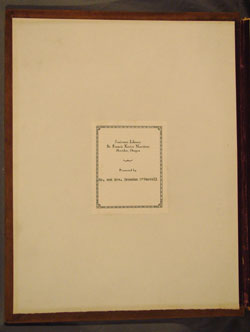
Book plate with donor names typed in: "Juniorate Library / St. Francis Xavier Novitiate / Sheridan, Oregon / Presented by / Mr. and Mrs. Brendan O'Farrell." In A62, Book of Armagh (modern edition with facsimiles).
Added entry: St. Francis Xavier Novitiate, Sheridan, Oregon, 1932-1966, when it became a Scholasticate, in existence 1966-1983 (information from Fr. Fredric W. Schlatter, 7-25-06). Formally named "Jesuit Novitiate of Sheridan, Oregon," on April 14, 1936 (information from Fr. Fredric W. Schlatter, S.J., in August 2006).
Tuquet: see Collegium Tuquetanum....
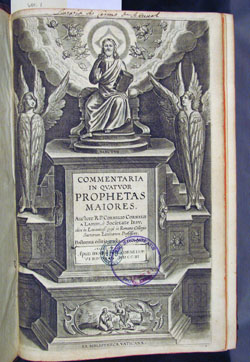
Washington: see BIBLIOTHECA / SEATTLE..., GONZAGA..., Jesuit Scholasticate Library..., [Mount St. Michael’s], and OLD BOOKS.
WAY: One of Gonzaga's two bound manuscripts (zz011) has handwritten owner names on front endpaper, including R. E. Way 1936; his engraved book plate is also inside the front cover: Robert Edward Way.
A "facsimile" edition of a manuscript is literally the result of the attempt to "make [a copy] like" the original, usually by photographic reproduction. However, to produce the 1786 facsimile edition of the Codex Alexandrinus, made before the invention of photography, a special set of type was created, to reproduce in print all the letter forms of the original manuscript. And the modern deluxe facsimile of the Book of Kells recreates not just the individual folios of this biblical manuscript with the full-color medieval illuminations, but also the same details of binding that the original has.
Gonzaga University owns a generous number of facsimile editions of ancient and medieval manuscripts of classical, liturgical, and biblical texts, including both of those just mentioned. Many of these facsimiles are in The Gonzaga Collection. In addition, several sophisticated research tools are housed in Special Collections. A partial list is given here. Unless otherwise indicated, the works are in Special Collections. For additional works, use the Foley library online catalog to search for "facsimile facsim. Faksimile facs. faks." [any of these] as KEYWORD ANYWHERE. To restrict your search to Special Collections, use the "Add Limit" option.
Facsimile editions:
a. Classical text:
Il codice mediceo di Virgilio...
b. Biblical texts:
Bibliorum Sacrorum graecus Codex vaticanus
Codex Sinaiticvs ... [1911 facsimile]
Codex Sinaiticvs ... [1922 facsimile]
Rabbula Gospels (586) in Syriac
Book of Kells, 3 vols.
The Leningrad Codex [Hebrew], the oldest complete Hebrew Bible extant
The Four Gospels from the Munich ms. (q.)...
Novum Testamentum Graecum, e codice Ms. Alexandrino..., 5 vols.
Codex 1 of the Gospels and its allies [in the stacks of the general collection]
The Gutenberg Bible (1454)
c. Liturgical texts:
Le codex 121 de la Bibliothèque d’Einsiedeln ... [1st floor Oversize]
Les principaux manuscrits de chant ... [1st floor Oversize]
Cantorium de Saint-Gall [1st floor Oversize]
The Medici Codex of 1518 [general collection]
d. Art texts
Les tres riches heures de Duc de Berry
William Blake’s The Book of Thel (1789)
e. Literary texts:
Boccaccio’s De casibus illustrium virorum (1520).
Agostino Dati’s study of Cicero (1479)
Chaucer’s Canterbury Tales,
both the Hengwrt Manuscript (c. 1400) and
the first collected edition, printed 1532.
Middle English works by Caxton and Wynken de Worde (1477, 1496, 1500)
Milton’s poems (1645)
Gerard Manley Hopkins later poetic manuscripts
f. Historical documents and works
Nuremburg Chronicle (1493)
Christopher Columbus, his own book of privileges, 1502
Thomas Jefferson’s autograph manuscript of the Life and Morals of Jesus of Nazareth.
original journals of the Lewis and Clark expedition
several works pertaining to the Jesuit Missions in the Pacific Northwest and to Native American language and history of the region.
g. Research Tools
E. A. Lowe, Codices latini antiquiores, a masterful twelve-volume collection of facsimile portions from Carolingian manuscripts (SPEC COLL Z114.C677).
"History of the Art of Writing" with 200 facsimiles reproduced from manuscripts and inscriptions.
Quite valuable are books printed before 1500. Gonzaga University owns three of these, called incunabula from the Latin word for 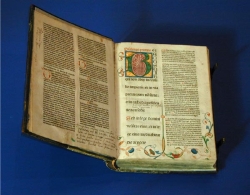 "cradle" because they were printed in the "cradle days" of printing. The Bruno Psalter of 1475 is the oldest printed book (incunabulum) at Gonzaga.
"cradle" because they were printed in the "cradle days" of printing. The Bruno Psalter of 1475 is the oldest printed book (incunabulum) at Gonzaga.
The University’s other two incunabula are from The Gonzaga Collection. The rare Roman Missal of 1484 records the pre-Tridentine Latin liturgy. Gonzaga owns one of only two known copies outside the Vatican. This volume is currently accessed by temporary code M58 and is not yet on the electronic catalog.
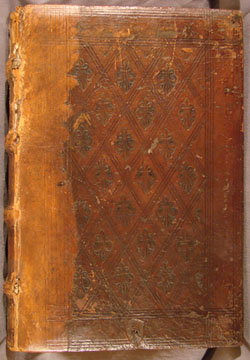 Fifteenth-century printers often recycled old manuscripts by using leaves cut from them in lieu of end-papers: The 1490 Summa Theologica by Antoninus is all the more valuable, for instance, because it has manuscript leaves from 1290 as its "paste downs" (A42). This volume is currently accessed by temporary code A42 and is not yet on the electronic catalog.
Fifteenth-century printers often recycled old manuscripts by using leaves cut from them in lieu of end-papers: The 1490 Summa Theologica by Antoninus is all the more valuable, for instance, because it has manuscript leaves from 1290 as its "paste downs" (A42). This volume is currently accessed by temporary code A42 and is not yet on the electronic catalog.

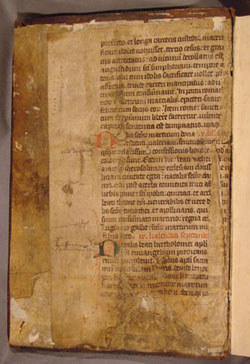
A few medieval and early modern manuscripts are owned by Gonzaga University. In addition are many valuable facsimiles of manuscripts.
Portions of medieval manuscripts are found as "pastedowns" in Gonzaga's oldest printed books, incunabula. The practice of fifteenth-century printers was to recycle leaves from manuscripts as facings for the inside of the covers of printed books. Perhaps the oldest of these "pasted down" manuscript leaves at Gonzaga is a leaf from a martyrology dated to 1290. It is the back pastedown in the 1490 edition of the Summa Theologica of Antoninus.
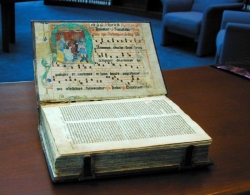 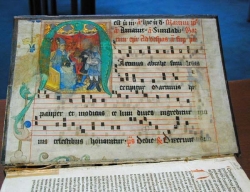 |
|
|
Antiphonary leaves from the thirteenth or fourteenth century are found as pastedowns in the Bruno Psalter of 1475. |
Two complete seventeenth century manuscripts on Aristotle are part of The Gonzaga Collection. Notably, each is on a "template book," a printed blank book prepared by stationers for students to use for taking notes for a course or for scholars to use when preparing a manuscript for publication. Gonzaga owns one of each type, and each template book is rather elegant, with marbled endpapers and an engraved frontispiece or title page. Thus these volumes have additional interest as attesting a little studied aspect of the history of the book.
From 1670 is the reportatio of the student John Middleton. A reportatio is a transcription of a series of lectures. Middleton wrote this autograph manuscript in a ready-made volume: a bound, prepared block of pages with marbled end pages and edges, engraved frontispiece and ornamented form for the titlepage and with ruling lines on the block of pages. This template book includes a frontispiece: a bust portrait of Aristotle in an oval frame inscribed: PHILOSOPHUS ARISTOTELES HOMO GRÆCUS. The French caption is biographical: "Aristote prince des Peripateticiens et j.er de tous les Philosophes eut pour pere Nicomacus medicin. Il fut precepteur d’alexandre le grand qui luj porta une si grande affection, qu’a sa seule consideration il retablit sa patrie, qu’il avoit ruinée. Enfin il mourit aagé de soixante et huict ans, la mesme année que mourut Demostene apres avoir escrit plus de trois cent tomes. [signed:] B.M. avec p." The book concludes with a usual colophon: "Finis undecimo die Maii Anno Domini 1670 Joannes Middleton." The next page is headed "Index Disputorum ac Quæstionum Quæ In hoc Libro Continent[u]r," but Middleton did not compile an index.
Probably the Jesuit scholar Ioanne Baptiste de Fourmestraulx is the author of the 1693 commentary on Aristotle's physics entitled Liber summus phisicorum. Fourmestraulx wrote this autograph manuscript in a ready-made volume with ruling lines on the block of pages and with marbled endpapers. Although this volume lacks a frontispiece, it has an engraved illustrated border for the titlepage, consisting of ten bust portraits with names inscribed. In the top row are "Aristoteles, Thomas [Aquinas], Plato"; on the left side: "Seneca, Socrates"; on the right side: "Pythagoras, Epicurus"; and in the bottom row: "Erasmes, Porphyruis [!], Diogenes."
St. Antoninus, Archbishop of Florence, was a Dominican reformer and theologian. Although his baptismal name was Anthony, he was known by the diminutive Antoninus because he was widely beloved. For his theological acumen, he took part in the Council of Florence (1439). Shortly before his death in 1459, he wrote a four-volume Summa Theologica focusing on morality. This work was quite popular. In the fifteenth and sixteenth centuries several abridged versions were also prepared for use as manuals for confessors and penitents.

Antoninus' Summa was first printed in Venice in 1477 (Gonzaga Inv A42). During the next fifty years fifteen more editions appeared throughout Europe. The Gonzaga Collection owns the fourth volume of the 1490 edition published in Strassburg by Johann (Reinhard) Grüninger; the fourth part was dated 3 July 1490. Only four other libraries in the world are identified as owning one or more parts of this edition, in the international library catalog recording the holdings of over 60,000 libraries (WorldCat).
The front cover is hand tooled.

| Shown here is the first page of this volume, which lacks a title page. The publication information is found in the colophon at the end of the volume. In the upper left margin is the round red book stamp of the Jesuit College at Louvain, with IHS in the center of the stamp. The stamp reads: "Coll. Max. S.J. Lovan. Bibliotheca" on the circumference with IHS (the abbreviation of the name Ihesus) as the center. |

On the facing page, shown here, are more Jesuit book stamps in the lower right margin. The oval stamp is from the Jesuit College at Tuquet near Mousquet in Belgium. The stamp reads: "Collegium Tuquetanum Beatæ Mariæ Virginis, IHS."
The printer left an area blank for a calligrapher to add a colored initial, in imitation of the decoration of medieval manuscripts. The omitted letter is the B of Benedictionem. For an incunabulum with hand-illuminated initials, see the 1484 Roman Missal in The Gonzaga Collection.
Water damage washed away an area of printing in the right column. One can see that the water staining in the lower and outer margins affected both this page and the one facing it, shown above.

Printers of early books often "recycled" old manuscripts by using leaves from them as pastedowns lining the inside of the covers. The front pastedown is shown to the left.
In the upper left corner is the book plate of the Jesuit College in Bologna. The plate reads: Bibl. Coll. Bolon. Soc. Jesu.
 To the right is seen the folio from a medieval manuscript used as a pastedown on the inside back cover of this volume. Although the folio was pasted in upside down in the book, it is shown right side up here, so that the text can be read. The alternation of red and blue initials on this folio was common in medieval manuscripts. A penciled note identifies this as a leaf from a martyrology written in 1290. It may be the oldest physical item in the rare holdings at Gonzaga University.
To the right is seen the folio from a medieval manuscript used as a pastedown on the inside back cover of this volume. Although the folio was pasted in upside down in the book, it is shown right side up here, so that the text can be read. The alternation of red and blue initials on this folio was common in medieval manuscripts. A penciled note identifies this as a leaf from a martyrology written in 1290. It may be the oldest physical item in the rare holdings at Gonzaga University.
The full text of this four-volume work is in the stacks at the Foley Library, in a modern facsimile edition of the noted 1740 edition printed in Verona [Oversize BX1749.A65 1740 (facsim) 1959]. Because Antoninus treated juridical matters so thoroughly here, the Chastek Law Library at Gonzaga University also owns a microform copy of that edition (BX1935.H4 No. 146 in the microfiche collection).
page created 3-5-08 CBT
 The Bruno Psalter of 1475 is the oldest printed book (incunabulum) at Gonzaga. The book's attractive layout presents the text of the psalms in one column alongside a second column with the commentary of Bruno, Bishop of Würzburg (d. 1045), who was learned in Greek and Hebrew. Historically this was the first work printed in Würzburg, by Reyser. As shown here, the first page of the Psalter was illuminated, that is, it was decorated by hand with gold as well as colored ink. In this way the printer continued the practice of medieval scribes of adorning the first word of the first psalm, which begins with the words "Beatus vir" (Blessed is the man...). The Bruno Psalter of 1475 is the oldest printed book (incunabulum) at Gonzaga. The book's attractive layout presents the text of the psalms in one column alongside a second column with the commentary of Bruno, Bishop of Würzburg (d. 1045), who was learned in Greek and Hebrew. Historically this was the first work printed in Würzburg, by Reyser. As shown here, the first page of the Psalter was illuminated, that is, it was decorated by hand with gold as well as colored ink. In this way the printer continued the practice of medieval scribes of adorning the first word of the first psalm, which begins with the words "Beatus vir" (Blessed is the man...). |
|
|
 In book construction, a sheet of material is "pasted down" on the inside of the cover and can extend onto the first page of the text block. In later books, in which paper is used for the pastedowns, they are usually called "endpapers." In many incunabula, however, these "pastedowns" are actually folios from medieval manuscripts. In book construction, a sheet of material is "pasted down" on the inside of the cover and can extend onto the first page of the text block. In later books, in which paper is used for the pastedowns, they are usually called "endpapers." In many incunabula, however, these "pastedowns" are actually folios from medieval manuscripts. |
|
|
Th e manuscript pastedown at the back of the Bruno Psalter is possibly from the prior page of the same antiphonary. The antiphon Te gloriosus Apostolorum is used for All Saints (November 1), and here seems to be used for November 9 as well, given that there is a reference to Theodor, who is mentioned in the Oratio for the Dedication of the Archbasilica of the Most Holy Savior (Lateran?) on November 9. Liturgical instructions are often called rubrics because of the custom of writing them in red, as seen here. [Antiphonary details from Professor Edward Schaefer] e manuscript pastedown at the back of the Bruno Psalter is possibly from the prior page of the same antiphonary. The antiphon Te gloriosus Apostolorum is used for All Saints (November 1), and here seems to be used for November 9 as well, given that there is a reference to Theodor, who is mentioned in the Oratio for the Dedication of the Archbasilica of the Most Holy Savior (Lateran?) on November 9. Liturgical instructions are often called rubrics because of the custom of writing them in red, as seen here. [Antiphonary details from Professor Edward Schaefer] |
|
The contemporary or near-contemporary binding of |
 |
 |
 |
|
|
 |
 Literal bookworms do exist and have for centuries: here is evidence of one, in the margin.
Literal bookworms do exist and have for centuries: here is evidence of one, in the margin.
Early printed books imitated the abbreviations used in manuscripts. The text shown beside the worm hole is "Ego autem in domino et non in mea iusticia, sed in fide divine protectionis gaudebo." In several places, abbreviations have been used, including a "suspension mark" above a word, to mark the omission of one or more letters, usually an m or n. An example is the word autem which appears simply as aut with a suspension mark. Names for God and the saints, nomina sacra, are frequently abbreviated. The standard abbreviation for dominus (Lord) is dn plus the final letter of the word, to indicate its grammatical case.
A volume which may be quite literally unique has been selected for a sample display, here, of the University's desire to digitize the treasures in The Gonzaga Collection. The Dominican Missal of 1521 is not otherwise attested; the copy at Gonzaga University may be the only surviving one from this deluxe edition. Thus, it is a fine choice for showing the value of digitizing important works in order to make them available for scholarly study and the enjoyment of all.
This particular work is, moreover, an elegant example of the bookmakers' art. The text itself is rubricated, with focal letters and passages printed in red (Latin: ruber). A wealth of woodcuts provide "most beautiful pictures" (pulcherrimis figuris). Woodcuts fill the entire opening at the start of major feasts (in capite missarum festivitatum), such as Palm Sunday (fols. 63v-64). Woodcut initials (ca. 1 1/8" high) begin several texts, and woodcut illustrations (ca. 2 3/8" high) are found at the head of Gospel lections. In addition, portrait-woodcuts of the evangelists and the Apostle Paul can stand beside verses taken from their writings, and portrait-woodcuts of specific saints appear beside prayers mentioning them. For Christmas, special initial woodcuts were used, depicting Christmas scenes. Gregorian chant in the style used by the Dominicans is recorded in this volume. This missal also records valuable evidence for the Christian understanding and affirmation of women. The volume was clearly valued, for it was rebound with care, with skillful, colorful marbling on the slipcase, the book covers, and the endpapers.
Currently Gonzaga University is entering full bibliographic records for all volumes in The Gonzaga Collection into its library database, Voyager, and also into the international library database, WorldCat. As of May 31, 2009, bibliographic records for 75% of the collection have been entered into these databases. Once electronic records exist for all of the titles, then it will be possible to undertake a true digitizing project, for such a project requires the bibliographic "metadata" as part of each image. A high-quality digital camera was used for taking the images shown below.1 In order to digitize whole books from The Gonzaga Collection additional materials will be needed, including specialized software. Many valuable works will be made widely accessible through digitization. For instance, the Bruno Psalter, the Roman Missal of 1484, the 1518 edition of St. Thomas, the Dominican Missal, and the Opera Omnia of Martin Luther. Some of the volumes to be digitized are literally unique, with no other copy of that edition know to exist in the world, while others contain unique features, such as the Melanchthon annotations in the Opera Omnia of Luther.
To protect the Dominican Missal of 1521 while it was being photographed, an acid-free cardboard bookstand was constructed specifically for it, by conservator Kathleen B. Orlenko. The stand holds the book open only partway, thus protecting the volume from any stress upon the spine or binding. Also, the stand is just a fraction smaller than the book in dimensions, so that it perfectly supports the entire book but does not appear obtrusively in the photographs. Finally, mylar strips were carefully placed to hold the book open, one strip on the outer margin of each page. These strips were placed on the pages just below the one being photographed, so the mylar does not appear in the photographs. By direction of Stephanie Plowman, similar techniques are also to be used in displays of rare books at Gonzaga University's Cowles Rare Book Library.
The present webpage you are reading simply presents digitized images of fifty-some images from The Dominican Missal, with notes added. The plan is to digitize the entire Dominican Missal and other treasures in full, when they are on the electronic catalog.
Please note that this webpage can also be used to study Latin, both liturgical texts and also the abbreviations and spellings used in medieval manuscripts and continued in early printed books. Latin teachers and also those who study Latin on their own may find this site useful. In addition, a linked webpage devoted to the woodcuts of the Dominican Missal is included, with suggested projects for curricular use or for independent study. As an expression of Gonzaga University's commitment to the Catholic humanistic tradition, this online tool is available to all, as a source of curricular support and enrichment.
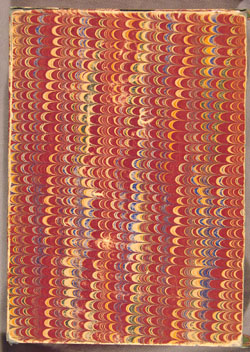
Missale predicator[um] nuper impressum ac emendatum cum multis missis orationibus: pulcherrimisq[ue] figuris i[n] capite missarum festivitatum sele[n]nium de novo superadditis: ut inspicienti patebit. Venice: Luc' Antonio Giunta, 1521. (The Gonzaga Collection: Rare Books from the Jesuit Heritage, Inv. No. M56)
The slipcase of the Dominican Missal of 1521 is entirely marbled, in a pattern which matches the cover and endpapers.
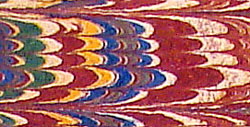 The decoration of the Dominican Missal of 1521 is at once visible in the exquisite marbling of slipcase, covers, and endpapers . In addition, a great variety of well-executed woodcuts adorns the volume. The use of gradated fonts mimics the decorative writing style of manuscripts. The sheer numbers are impressive:
The decoration of the Dominican Missal of 1521 is at once visible in the exquisite marbling of slipcase, covers, and endpapers . In addition, a great variety of well-executed woodcuts adorns the volume. The use of gradated fonts mimics the decorative writing style of manuscripts. The sheer numbers are impressive:
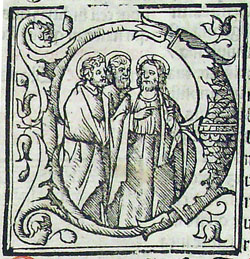 Although just one sixth of this missal, about one hundred pages, has been digitized, those pages alone feature 352 prints from woodcuts from nearly 300 individual designs. A particular cultural value of these woodcuts is in their presentation of biblical and liturgical knowledge. In addition they can be used to study a variety of topics including women in the Church, liturgical practices, even contemporary musical instruments, for several of these are shown in a headpiece.
Although just one sixth of this missal, about one hundred pages, has been digitized, those pages alone feature 352 prints from woodcuts from nearly 300 individual designs. A particular cultural value of these woodcuts is in their presentation of biblical and liturgical knowledge. In addition they can be used to study a variety of topics including women in the Church, liturgical practices, even contemporary musical instruments, for several of these are shown in a headpiece.
The present webpage discusses the woodcuts and the gradated fonts. At the end information on the famous Italian publisher is given. The University owns several books by this publisher, as part of The Gonzaga Collection: Rare Books from the Jesuit Heritage. These books are identified in the last paragraph below. Finally, possible projects for class or individual study are suggested at the end. The main webpage on the Dominican Missal has further information on several individual woodcuts and so should be read in conjunction with this page.
 Woodcuts in the Dominican Missal of 1521 are numerous and varied. Generously decorated openings (the two pages seen when the book is opened) are found at the start of major feasts\ and always include a big woodcut depicting the feast as well as a special large initial containing a scene associated with the feast. In addition one finds numerous vignettes depicting Gospel lections as well as portrait-woodcuts depicting biblical authors and saints. Historiated initials contain images of persons and even events. In addition, woodcut initials decorated with floral and vegetal motifs are found. Some distinctive liturgical woodcuts are also included. A small proportion of the woodcuts are repeated in this missal, but most appear in it only once. Each category of woodcut is treated below, with examples. The text-area on the Dominican Missal's page is 35 lines high, and the woodcuts range in height from 29 lines down to two lines.
Woodcuts in the Dominican Missal of 1521 are numerous and varied. Generously decorated openings (the two pages seen when the book is opened) are found at the start of major feasts\ and always include a big woodcut depicting the feast as well as a special large initial containing a scene associated with the feast. In addition one finds numerous vignettes depicting Gospel lections as well as portrait-woodcuts depicting biblical authors and saints. Historiated initials contain images of persons and even events. In addition, woodcut initials decorated with floral and vegetal motifs are found. Some distinctive liturgical woodcuts are also included. A small proportion of the woodcuts are repeated in this missal, but most appear in it only once. Each category of woodcut is treated below, with examples. The text-area on the Dominican Missal's page is 35 lines high, and the woodcuts range in height from 29 lines down to two lines.
The title page sports two woodcuts: a large portrait of St. Dominic, and, at the foot of the page ... the printing device of Luca Antonio Giunta, the famous publisher. For a PDF of this page, click on the image at left. For more on Giunta, see the end of this webpage.
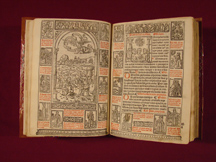 Decorated openings start every major feast in this missal. Each such opening is decorated with twenty-nine woodcuts arranged in the layout seen here. Shown here is the start of the liturgy for Christmas dawn (fols. 9v-10). Click on the image for its PDF. The regular alternation of small woodcuts and red captions frames each page. These smaller woodcuts include prophets who foretold the event celebrated in the feast, details of the event, and sometimes events from the Old Testament which foreshadowed the event in the life of Christ. For instance, for a Marian feast Moses is depicted before the burning bush, because Christians interpreted the bush which burned but was not consumed as a foreshadowing of Mary who was a mother but did not cease to be a virgin (fol. 171v, top right).
Decorated openings start every major feast in this missal. Each such opening is decorated with twenty-nine woodcuts arranged in the layout seen here. Shown here is the start of the liturgy for Christmas dawn (fols. 9v-10). Click on the image for its PDF. The regular alternation of small woodcuts and red captions frames each page. These smaller woodcuts include prophets who foretold the event celebrated in the feast, details of the event, and sometimes events from the Old Testament which foreshadowed the event in the life of Christ. For instance, for a Marian feast Moses is depicted before the burning bush, because Christians interpreted the bush which burned but was not consumed as a foreshadowing of Mary who was a mother but did not cease to be a virgin (fol. 171v, top right).
The book's largest woodcuts (29 lines high) are found consistently on the left page of each decorated opening and always depict the feast. That largest woodcut always is framed above and below by a headpiece (usually Christ amid the twelve apostles) and a floral tailpiece. Along each outer side of the page is a column of four small woodcuts (7 lines high), each with a rubricated caption. Below the largest woodcut is another pair of small woodcuts, with a floral piece between them. A geometric tailpiece runs across the page as a whole. On the right page this layout is repeated, except that here the largest woodcut (12 lines high) is a special initial depicting the feast and beginning the feast's opening antiphon. This woodcut does not have its own tailpiece. On both pages of such openings the marginal woodcuts depict prophecies of the feast and elements of it.
Three different headpieces are shown In the six fully decorated openings on this website: The most frequently used one presents Christ, in a cruciform halo, amid the twelve apostles, en buste (as seen in the opening above, on the left side). The other two depict holy women. One shows the Virgin Mary amid ten holy women, en buste. This headpiece is seen on the first decorated opening and again on fol. 16v. The other depicts a richly detailed coronation of the Blessed Virgin Mary. That headpiece is seen in the opening above on fol. 10, also on fol. 12. The mother of Jesus sits centrally on a low throne, so that though enthroned she remains in a humble position. The Trinity is crowning her: Christ at the left, God the Father at the right, and overhead the Holy Spirit in the form of a dove. Surrounding this group is an angelic choir playing a variety of instruments. Note that in the opening shown above, as on some other openings, the headpieces provide a balance of the sexes, with male saints on one side and female on the other.
The fully decorated openings available for viewing online are for the Annunciation (the opening with fol. 1), Christmas Eve (fols. 7v-8), Christmas dawn mass, with a large miniature of the angel's announcement to the shepherds (fols. 9v-10, shown above), the adoration of the shepherds (fols. 11v-12), the circumcision of the Lord (fols. 14v-15), Epiphany, with a large miniature of the Adoration of the Magi (fols. 16v-17), Palm Sunday, with Christ's Entry into Jerusalem (fols. 63v-64). Also, the section of the Missal concerned with feasts of saints begins with the feast of St. Andrew, with the Calling of Simon and Andrew (fols. 155v-156).
 On the righthand pages of these openings, the feast-specific large initials (12 lines high) show King David in an A beginning one of his psalms (fol. 1), Christ in a D (fol. 8, shown here), the coruscating Star of Bethlehem in the L of "Lux" (light, fol. 10), a nativity scene in a P (fol. 12), Christ returning to his mother after his circumcision (fol. 15), an angel proclaiming the birth of Christ (fol. 15v), the Adoration of the Magi (fol. 17), a monk kneeling in prayer before the face of God (fol. 29v), and Christ with two disciples in a D (fol. 64). The largest such initial, fully sixteen lines high, shows Andrew (or Peter?) leaping from their fishing boat toward Jesus to answer his call (fol. 156).
On the righthand pages of these openings, the feast-specific large initials (12 lines high) show King David in an A beginning one of his psalms (fol. 1), Christ in a D (fol. 8, shown here), the coruscating Star of Bethlehem in the L of "Lux" (light, fol. 10), a nativity scene in a P (fol. 12), Christ returning to his mother after his circumcision (fol. 15), an angel proclaiming the birth of Christ (fol. 15v), the Adoration of the Magi (fol. 17), a monk kneeling in prayer before the face of God (fol. 29v), and Christ with two disciples in a D (fol. 64). The largest such initial, fully sixteen lines high, shows Andrew (or Peter?) leaping from their fishing boat toward Jesus to answer his call (fol. 156).
In some images the termini (ends) of the letter containing the depiction are decorated with grotesque faces, as seen in the initial D at left (click on the image for a PDF of the opening with that initial.) Sometimes the grotesque faces can be large, as in the historiated initial S on fol. 171v (not yet digitized).
Every Gospel lection is represented in a miniature (13 lines high), always placed at the start of the pertinent reading. These pictures include Jesus' entry into Jerusalem (fol. 1v), John the Baptist in prison (fol. 2v), John the Baptist declaring that he is not the Christ (fol. 6v), the decree of Caesar Augustus with Joseph and Mary shown obeying it (fol. 8v, also seen in the upper right of fol. 7v), the encounter of the infant Jesus with Symeon in the Temple (fol. 14), the angel warning Joseph in a dream (fol. 16), the Magi (fol. 17v), Mary and Joseph finding the child Jesus teaching in the Temple (fol. 18), John baptizing Jesus in the Jordan (fol. 19), the wedding at Cana (fol. 19v), Jesus healing a leper (fol. 20v), Jesus calming the sea (fol. 21), the parable of the vineyard workers ("the last shall be first" -- fol. 22v), the parable of the sower and the seed (fol. 23v), Jesus prophesying his Passion to the disciples (fol. 24v, used again with his teaching the disciples how to fast, fol. 27), Jesus and the Centurion (fol. 27v), Jesus and his disciples with a city in the background (fol. 28v), a different depiction of Jesus calming the sea (fol. 29), the Temptation of Christ (fol. 30), Jesus foretelling his Second Coming (fol. 31), Jesus chasing the money-changers from the Temple (fol. 31v), Jesus asked by the scribes and Pharisees for a sign (fol. 32v), and Jesus questioned by a crowd and the Pharisees (fol. 33v).
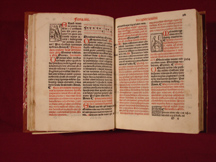 Two liturgical vignettes for Ash Wednesday appear on the opening of fols. 25v-26, shown here. Each woodcut is eight lines high. On the righthand page is seen the distribution of ashes on Ash Wednesday. The woodcut is adjacent to the words the priest speaks then: "Memento q[uod] cines es et in cinerem reverteris" ("Remember that you are ashes and into ashes you shall return"). The print shows a vested priest putting ashes on the crown of the head of a kneeling man. A woman is next in line to receive ashes, so this woodcut shows the balance of the sexes.
Two liturgical vignettes for Ash Wednesday appear on the opening of fols. 25v-26, shown here. Each woodcut is eight lines high. On the righthand page is seen the distribution of ashes on Ash Wednesday. The woodcut is adjacent to the words the priest speaks then: "Memento q[uod] cines es et in cinerem reverteris" ("Remember that you are ashes and into ashes you shall return"). The print shows a vested priest putting ashes on the crown of the head of a kneeling man. A woman is next in line to receive ashes, so this woodcut shows the balance of the sexes.
Portraits. Saints and biblical authors are the subjects of woodcuts thirteen lines high. Portraits include St. Anastasia (fol. 11), St. Andrew (fol. 156 at lower right), and the evangelists John (fol. 13), and Luke (fols. 3v, 10v, 15v) and Matthew (fol. 21v) and probably Mark on a folio not yet digitized. In addition, some portraits appear in historiated initials (seven lines high), namely King David in an A (fols. 21 and 21v), St. Lawrence in a C (fol. 22), and Sts. Peter and Paul in the two halves of a capital M (fol. 6). Another portrait of King David is included in the decoration of the first major feast, in the large historiated initial A (twelve lines high) which begins an antiphon based on one of his psalms (fol. 1). Many of these woodcuts are "author portraits," showing the author of the biblical text being quoted. Small portrait woodcuts are also found along the sides of the fully decorated openings. For instance, the prophet Isaiah who foretold the virgin birth is shown in a woodcut, third down on the left side, on fol. 171v, for the feast of the Purification of Mary.
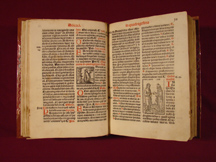 Historiated initials. Nearly a score of historiated initials (seven lines high) are viewable online. There are four different D's, three E's and a pair each of A's, C's and G's. In alphabetical order the designs are an A with a tonsured man who gestures with his right hand (fol. 20), an A with King David praying (fols. 21 and 21v) -- the initial is repeated with an antiphon which quotes from a psalm, because the entire Psalter was believed to have been composed by David -- a C with St. Lawrence with his gridiron (fol. 22), a C with a head facing to the right (fol. 33), a D with the newborn Christ and God the Father in Glory (fol. 13v), a D with a half-length figure (fol. 27), a D with a turbaned man's head (fol. 33v), an E with a monk kneeling, praying, being blessed by a standing monk (fol. 24), an E with an executioner with a sword standing behind a haloed, kneeling man (fol. 23), an E (starting the liturgy for the Octave of Epiphany) with four happy infants (fol. 18v), a G with a monk (prefatory page), a G with eleven haloed figures (fol. 2v), an H with a turbaned man who gestures with his left hand (fol. 6), an O with a vested priest at an altar (fol. 19v), a P with a man with a scroll (fol. 1v), and a Q with a man with a book (prefatory page).
Historiated initials. Nearly a score of historiated initials (seven lines high) are viewable online. There are four different D's, three E's and a pair each of A's, C's and G's. In alphabetical order the designs are an A with a tonsured man who gestures with his right hand (fol. 20), an A with King David praying (fols. 21 and 21v) -- the initial is repeated with an antiphon which quotes from a psalm, because the entire Psalter was believed to have been composed by David -- a C with St. Lawrence with his gridiron (fol. 22), a C with a head facing to the right (fol. 33), a D with the newborn Christ and God the Father in Glory (fol. 13v), a D with a half-length figure (fol. 27), a D with a turbaned man's head (fol. 33v), an E with a monk kneeling, praying, being blessed by a standing monk (fol. 24), an E with an executioner with a sword standing behind a haloed, kneeling man (fol. 23), an E (starting the liturgy for the Octave of Epiphany) with four happy infants (fol. 18v), a G with a monk (prefatory page), a G with eleven haloed figures (fol. 2v), an H with a turbaned man who gestures with his left hand (fol. 6), an O with a vested priest at an altar (fol. 19v), a P with a man with a scroll (fol. 1v), and a Q with a man with a book (prefatory page).
Other initials. Some initials are decorated simply, with flowers or leaves. Each is four lines high: a floreate A (fol. 28), a vegetal R (fol. 32), a vegetal S (fol. 30v), and a floreate V (fol. 4v). Also, a few initials which are simply larger than the normal type face of the missal are used, as a guide to the eye. Printed in red, these initials draw the eye to the start of a text. Thus, the initials C, F, O, and F are in red in the righthand column of fol. 29v. In the lefthand column is an initial P. On the facing page (fol. 30) in the righthand column the Gospel lection begins with a red, two-line high initial I. In imitation of medieval manuscripts, printers would follow a tall initial by a capital letter as tall as the rest of the text, and then by lower case letters. Thus one sees "PRepara" in the left column of fol. 29v and "CElistis" in the right column there. Aesthetically, it is more pleasing to go from a tall letter to a somewhat smaller one before returning to the usual size of letter.
Studying Latin in the Dominican Missal
Perusing the Dominican Missal, one can explore how Latin was presented in deluxe printing of the early sixteenth century. Moreover, teachers of Latin at all levels can use the digitized pages in class in various ways. Beginning students can gain the experience of seeing some already learned words in a beautifully printed rare book, while advanced students perhaps with specific interests in liturgical, biblical, or devotional texts can pursue detailed research. The iconography of the missal is best studied by readers of Latin, who can investigate how image and text correlate. The depictions and texts concerning women constitute an area of particular interest. The main webpage on the missal has thumbnail images of more than fifty openings (and so over 100 pages) from that missal. Many transcriptions of texts from those pages are provided alongside the thumbnail image. Thus the reader can compare the transcription with the original and can further read or even transcribe more of the texts. To access the PDF file, click on the thumbnail and then enlarge the PDF to get a large image of the opening for ease in reading the Latin (and studying the artwork).
Spelling and spacing. The Dominican Missal of 1521 is a convenient way to introduce students to the different ways of making certain letters and also to the pre-modern conventions in punctuation, spacing, and capitalization. On the titlepage (shown below) most words at the end of a line of type are carried over onto the next line. The modern convention is to insert a hyphen to alert the reader to the word-break, but in medieval manuscripts and early printed books the hyphen was rarely if ever used. The tall -s- seen in some of the founding documents of the United States, as in the word "Congress" (which looks in old documents like "Congreff") is a carryover from the ess seen in this printed book, as in the last word in the top line of the title. Often manuscripts and early printed books made no distinction between u and v or between i and j. The modern English norm is to capitalize the first word of each sentence and proper nouns, but often capital letters are reserved in medieval manuscripts for the start of sections of a text. Students who have learned classical Latin will discover that medieval spelling was in some instances simplified, with -e- used where classical Latin had -ae-. In particular, it is important to note that the feminine genitive singular ending, -ae, will often be found as simply -e. An example of this simplified spelling is found in the title page, seen right below, where the second word has -e- instead of a classical -ae- in the noun for "Preachers."
Abbreviations. Many abbreviations were used in printing, in imitation of the use of abbreviations in medieval manuscripts. Abbreviations were so common that they are even on the titlepages of early printed books.
 Missale predicator[um] nuper impressum ac emendatum cum multis missis orationibus: pulcherrimisq[ue] figuris i[n] capite missarum festivitatum sele[n]nium de novo superadditis: ut inspicienti patebit. Venice: Luc' Antonio Giunta, 1521. (The Gonzaga Collection: Rare Books from the Jesuit Heritage, Inv. No. M56)
Missale predicator[um] nuper impressum ac emendatum cum multis missis orationibus: pulcherrimisq[ue] figuris i[n] capite missarum festivitatum sele[n]nium de novo superadditis: ut inspicienti patebit. Venice: Luc' Antonio Giunta, 1521. (The Gonzaga Collection: Rare Books from the Jesuit Heritage, Inv. No. M56)
In the first line of the title the second word ends with an r with a line drawn down through it. That is a standard abbreviation for the genitive plural ending -um. In the fourth line the first word ends in a q with what looks like the number 3: that was a common abbreviation for the enclitic -que. In the fifth line the last word has an -e- with a line drawn over it. That line is called a "suspension mark" and indicates that a nasal letter (an m or n) has been omitted.
Women in the Dominican Missal
The presence of women in the iconography, texts, and liturgical calendar of the Dominican Missal of 1521 reflects a richly positive, ancient tradition. Already the digitized sample from that missal allows demonstration of how several women are positively depicted in that book and how women are throughout treated with respect. The complete digitizing of the volume will enable complete analysis of this important subject.
The tradition. Christianity, starting with the teachings and actions of Jesus himself, highlighted the spiritual equality of the sexes. The original revelation of Genesis had innovatively identified women as created equally in the image of God, and the Old Testament holds many accounts of women who were notable in their faith, courage, intelligence, successful prayers, and leadership.(1) Jesus emphasized the spiritual equality of the sexes by using pairs of parables featuring a woman and a man – such as the good shepherd and the good homemaker – and by interacting with women in ways that showed they were just as capable as men of understanding and professing the faith, seeking and receiving healing, interceding for others, etc.(2) This bore fruit at once in the equal access of both sexes to the sacraments of life – baptism and the Eucharist.(3) Although in the Temple in Jerusalem, women had been further from the sanctuary than the men, in Christian churches women “were included in the liturgy as a whole in exactly the same way as men” and were as close to the sanctuary.(4)
Also, starting in the first century, Christians began a pastoral program of the balanced representation of the sexes. This is widely evident in both texts and art.(5) St. James offered a sexually balanced pair of exemplars of faith, Abraham and Rahab (James 2:20-26), Clement of Alexandria (d. 215) preached a sermon affirming that “Women are Equally Capable with Men of Obtaining Perfection,” and St. John Chrysostom taught in a sermon that “You see everywhere vice and virtue, not differentiated by nature [i.e., sex], but by character.”(6) In the visual arts, frequently both a man and a woman are depicted in parallel ways. Both Adam and Eve are depicted at The Fall.(7) On a fourth-century ivory reliquary, a characteristic balance is seen, with both a man and a woman receiving healing, both a man and a woman being raised from the dead, and both a man and a woman dying because of sin.(8) A subject found several times in Early Christian art is the resurrection after death at a moment of personal judgment, and usually both a man and a woman are shown entering Heaven.(9) In churches, quite often both men and women are depicted adjacent to the sanctuary.(10) The Church calendar annually recalls both men and women important in salvation history, such as the Magi and the Women at the Tomb, and likewise commemorates both male and female saints.
Women in the Dominican Missal of 1521
This rich heritage of the balanced representation of the sexes is seen in the Dominican Missal of 1521. Depictions of women include several pictures of Mary, the Mother of God, as well as other holy women. Importantly, a woman is included in the liturgical woodcut for Ash Wednesday. Often an opening – the two pages visible when the book is opened – includes a balance of the sexes in its illustration. The subject of the balanced representation of the sexes is timely and deserves further exploration, and the Dominican Missal of 1521 offers a valuable means of advancing such research. The rest of this webpage surveys all the ways in which women are depicted in the digitized sample from this Missal, and then offers suggestions for projects to examine the topic further.

St. Catherine of Siena on titlepage? A woman is one of the four Dominicans surrounding St. Dominic on the titlepage. She is the figure at the far right. Given the holiness and cultural importance of St. Catherine of Siena, Doctor of the Church, it is likely that she is the specific woman depicted.
Roman Missal (1484)
The 1484 Roman Missal in The Gonzaga Collection is an incunabulum a book from the earliest days of printing (before 1500). Only two other copies of this volume are known to survive, one in the Vatican. The text is pre-Tridentine, that is, the mass as it was celebrated before the Council of Trent. The provenance (history of ownership) of this volume is also of interest. This book was presented to Mount St. Michael's Library on May 6, 1962 by Mrs. Charlotte Sanderson, the widow of Dr. Steven Sanderson. It is now part of The Gonzaga Collection.
Missale Romanum. Nuremberg: Georg Stuchs, 1484 (SPEC COLL BX2015.A2 1484
The Gonzaga Collection also contains five other Roman Missals, one from 1577 shortly after the Council of Trent; a Mozarabic Missal; and the Dominican Missal of 1521.
This handsome volume was printed in black and red inks. Liturgical manuscripts and printed 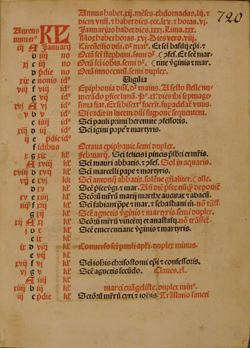 books which use red (ruber) ink for certain passages are called "rubricated." In liturgical texts, red ink was used to distinguish directions from the words that would actually be spoken as part of the liturgy. In calendars, red ink was also used to name important feasts. This led to the idiom of referring to a special occasion as a "red letter day." Seen here is the opening of the calendar in the 1484 Missal. The handwritten number in the upper right corner, 720, is some of the evidence of the book's provenance.
books which use red (ruber) ink for certain passages are called "rubricated." In liturgical texts, red ink was used to distinguish directions from the words that would actually be spoken as part of the liturgy. In calendars, red ink was also used to name important feasts. This led to the idiom of referring to a special occasion as a "red letter day." Seen here is the opening of the calendar in the 1484 Missal. The handwritten number in the upper right corner, 720, is some of the evidence of the book's provenance.
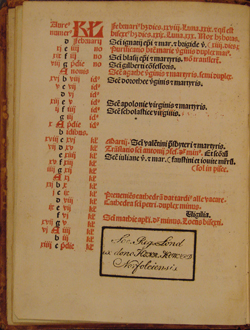
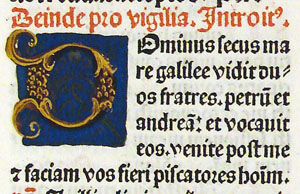
Several of the large initials in this missal were hand-illuminated in blue and gold. To do this, the printer would leave a blank area in the printed page where the initial belonged, and then the artist would paint the initial. The initial "D" starting the word "Dominus" is seen on folio 160, shown above. To the left is a detail of just that initial D and the surrounding text. The initial "S" is seen on folio 168. Sadly, a modern vandal excised some of these initials, as is evident on folio 179.
The text with the initial D is the start of the Gospel recounting the calling of Peter and Andrew. Above the initial is the rubric: "Deinde pro vigilia. Introit[us]" The initial D in blue and gold is followed by rest of the letters of the word Dominus, with the O larger than the rest of the letters: "Dominus secus mare galilee vidit duos fratres, petru[m] et andrea[m]: et vocauit eos. venite post me [et] faciam vos fieri piscatores ho[m]i[nu]m."
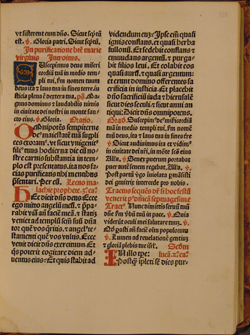
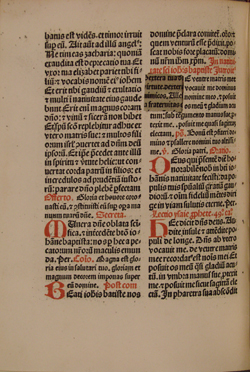
Owner notes have been added in a few places. For instance, a previous owner penciled these notes, shown to the right, on the front fly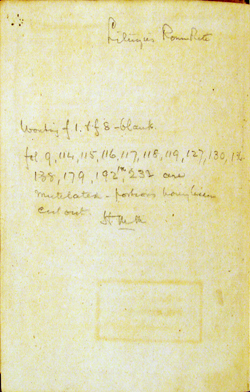 leaf facing the first page of printed text. (This leaf was added when the book was rebacked and rebound by the Royal Society of London in the late seventeenth century.) The top line of the penciled notes reads "Liturgies Roman Rite" The longer note below reads "fol. 9, 112, 115, 116, 117, 118, 119, 127, 130, 136, 138, 179, 192, 232 are mutilated - portions having been cut out." Each removed portion was cut out neatly. Most cut-out pieces were colored initials. One was round (1.5" in diameter), evidently a book stamp in the bottom margin of a page; traces of maroon or dark brown ink remain on the edges of the hole.
leaf facing the first page of printed text. (This leaf was added when the book was rebacked and rebound by the Royal Society of London in the late seventeenth century.) The top line of the penciled notes reads "Liturgies Roman Rite" The longer note below reads "fol. 9, 112, 115, 116, 117, 118, 119, 127, 130, 136, 138, 179, 192, 232 are mutilated - portions having been cut out." Each removed portion was cut out neatly. Most cut-out pieces were colored initials. One was round (1.5" in diameter), evidently a book stamp in the bottom margin of a page; traces of maroon or dark brown ink remain on the edges of the hole.
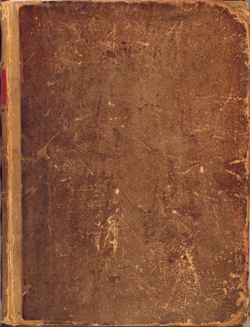
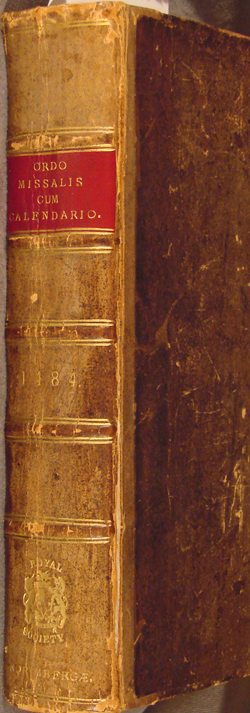 After receiving this volume as part of a "noble gift" from the Duke of Norfolk in 1667, The book was rebound and rebacked, probably in the 1680s. The spine is stamped with gilt giving the contents (Ordo Missalis cum calendario), the date of publication (1484), and, at the bottom of the spine, the place of publication: "Norimberge" (Nuremberg). Just above the place of publication is the crest of the Royal Society of London.
After receiving this volume as part of a "noble gift" from the Duke of Norfolk in 1667, The book was rebound and rebacked, probably in the 1680s. The spine is stamped with gilt giving the contents (Ordo Missalis cum calendario), the date of publication (1484), and, at the bottom of the spine, the place of publication: "Norimberge" (Nuremberg). Just above the place of publication is the crest of the Royal Society of London.
Catherine Brown Tkacz, Ph.D.
Provenance of the Roman Missal
Intriguingly, the copy of the 1484 Roman Missal in The Gonzaga Collection was formerly owned by the Arundel family, one of the most unwaveringly Catholic noble houses in England. In 1667 Henry Howard, the sixth Duke of Norfolk and also the son of the twenty-second Earl of Arundel, gave his library, including this incunabulum to the Royal Society in London, of which he was a member. The noted diarist Samuel Pepys described this donation as a "noble gift."1 Ironically, Howard and all other Catholics were at about the same time disbarred form sitting in Parliament because of their religion.
In 1681 William Perry, the first "Library Keeper" of the Royal Society, stamped the books of the Norfolk donation.2 The copy in The Gonzaga Collection clearly bears the stamp on the verso of folio 2: "Soc. Reg. Lond. / ex dono HENR. HOWARD / Norfolciensis." The number 720 on the front of this folio in the upper right may be part of the Royal Society's markings as well.

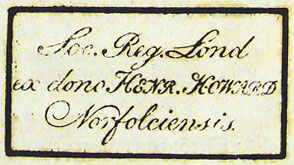

Later Henry E. Huntington, founder of the famous Huntington Library in California, acquired the volume. This is attested by the "H.E.H." book stamp inside the back cover.
This book was presented to Mount St. Michael's Library near Spokane on May 6, 1962, by Mrs. Charlotte Sanderson, the widow of Dr. Steven Sanderson, as recorded in a typed record on the library's letterhead. Possibly that record should have identified the prior owner as "Stevens Sanderson," for that is the name on the bookplate on the 1521 Dominican Missal, which evidently was also donated.
Catherine Brown Tkacz, Ph.D.
1. Linda Levy Peck, "Uncovering the Arundel Library at the Royal Society: Changing Meanings of Science and the Fate of the Norfolk Donation," Notes and Records of the Royal Society of London 52.1 (1998): 3-24, at p. 4.
2. Peck, "Arundel Library," p. 6.